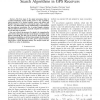Free Online Productivity Tools
i2Speak
i2Symbol
i2OCR
iTex2Img
iWeb2Print
iWeb2Shot
i2Type
iPdf2Split
iPdf2Merge
i2Bopomofo
i2Arabic
i2Style
i2Image
i2PDF
iLatex2Rtf
Sci2ools
PIMRC
2010
IEEE
2010
IEEE
On the detection probability of parallel code phase search algorithms in GPS receivers
The first stage of the signal processing chain in a Global Positioning System (GPS) receiver is the acquisition, which provides for a desired satellite coarse code phase and Doppler frequency estimates to subsequent stages. Thus, acquisition is a two-dimensional search, implemented as demodulation and non-coherent correlation. For a certain Doppler estimate, software-defined GPS receivers typically compute the correlation for all time lags in parallel. One way to detect the presence of a signal is by comparing the ratio between the largest and the second largest correlation peak against a threshold. For this type of receivers, the detection and false alarm probabilities are derived. Interestingly, the false alarm probability is independent of the noise power spectral density, which allows a fixed threshold setting. The analytic results are verified by a series of simulations.
| Added | 14 Feb 2011 |
| Updated | 14 Feb 2011 |
| Type | Journal |
| Year | 2010 |
| Where | PIMRC |
| Authors | Bernhard Geiger, Michael Soudan, Christian Vogel |
Comments (0)

